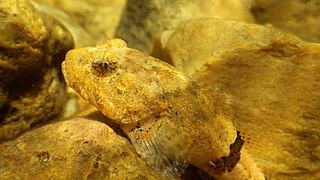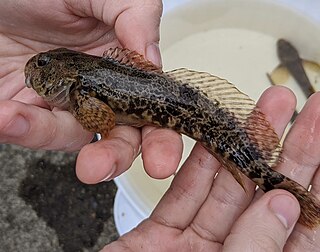
The spoonhead sculpin is a species of freshwater ray-finned fish belonging to the family Cottidae, the typical sculpins. This species is widespread in northeastern North America.

The slimy sculpin is a freshwater species of fish belonging to the family Cottidae, which is the largest sculpin family. They usually inhabit cold rocky streams or lakes across North America, ranging from the Great Lakes, southeast Minnesota, northeast Iowa, southwest Wisconsin and northeast Canada. Slimy sculpins have also been found roaming the cold streams of eastern Siberia. They are commonly confused with their closely related relatives, Mottled sculpin, and with tubenose gobies who are both freshwater fishes as well. The slimy sculpin is a nocturnal fish that usually spends most of its time on the stream bottom and seeks shelter under rocks and logs, especially during spawning season. When it swims, it sometimes appears to be "hopping" along the bottom because of its inefficient ability to swim. This is partly due to the absence of a swim bladder, which normally gives buoyancy to a fish.

Cottus is a genus of the mainly freshwater ray-finned fishes belonging to the family Cottidae, the typical sculpins. They are often referred to as the "freshwater sculpins", as they are the principal genus of sculpins to be found in fresh water. They are native to the Palearctic and Nearctic.

The mottled sculpin is a species of freshwater ray-finned fish belonging to the family Cottidae, the typical sculpins. This species has a wide but scattered North American distribution.

The European bullhead is a freshwater fish that is widely distributed in Europe, mainly in rivers. It is a member of the family Cottidae, a type of sculpin. It is also known as the miller's thumb, freshwater sculpin, common bullhead, and cob.
The Bear Lake sculpin occasionally referred to incorrectly as a "bullhead", is a species of freshwater sculpin endemic to Bear Lake on the Utah-Idaho border. It is one of only four sculpins native to Utah, and the only extant lake-dwelling sculpin in Utah. Although the fish is only native to Bear Lake, it has been introduced and established in Flaming Gorge Reservoir.

The Klamath Lake sculpin is a species of freshwater ray-finned fish belonging to the family Cottidae, the typical sculpins. It is endemic to the Agency and Upper Klamath Lakes in Oregon, USA. It reaches a maximum length of 7.0 cm. It prefers rocky and sandy shores of the lakes.
The pygmy sculpin is a species of ray-finned fish belonging to the family Cottidae, the typical sculpins. It is endemic to Alabama in the United States. It inhabits Coldwater Spring and its associated spring run in the Coosa River and Choccolocco Creek systems.

The slender sculpin is a species of freshwater ray-finned fish belonging to the family Cottidae, the typical sculpins. It is endemic to the United States, occurring only in the upper Klamath Lake river drainage in Oregon. It is found along lake shores over mud, sand and gravel, and in the riffles, runs and pools of streams and rivers. It reaches a maximum length of 9 cm.

The fourhorn sculpin is a species of ray-finned fish belonging to the family Cottidae, the typical sculpins. This species has a Holarctic distribution and can be found in marine, brackish and fresh waters.

The banded sculpin is a freshwater fish dwelling mostly in small to moderate sized streams in areas of swift current. Young and juvenile C. carolinae can mainly be found in pools, riffles, and other shallow habitats while adults tend to prefer deeper waters. C. carolinae primarily eats insects and insect larvae, but their large mouths enable them to eat prey nearly as large as themselves, including other sculpin. To prevent predation, including by other fish, the color and pattern of the sculpin tends to match its environment. Most Cottus carolinae are mottled brown with dark vertical banding and usually reach about three inches in length. They have a broad head which rather quickly narrows into a slim body, giving them the appearance of a tadpole reaching adulthood.
Kessler's sculpin is a species of Baikal sculpin, a freshwater fish native to Russia and Mongolia where it occurs in Lake Baikal and surrounding lakes as well as the Selenga, Angara and Bain Gol rivers. It is the only member of its genus. In Lake Baikal it occurs on sandy, rocky-sandy or sandy-muddy bottoms, ranging from relatively shallow water to depths of 70 m (230 ft). In rivers they mainly occur in slow-flowing channels and floodplains.

The Coastrange sculpin is a freshwater sculpin of the genus Cottus. They are commonly found near the ocean in western North America, namely Canada and the United States. It is also known as the Aleutian sculpin.

The prickly sculpin is a species of ray-finned fish belonging to the family Cottidae, the typical sculpins. It is native to the river drainages of the Pacific Slope of North America from Seward, Alaska south to the Ventura River of Southern California. It extends east of the Continental Divide in the Peace River of British Columbia. It has also been introduced to several reservoirs in Southern California.

The Potomac sculpin is a freshwater species of sculpin that lives in West Virginia, Maryland, Virginia and Pennsylvania.

The Paiute sculpin is a species of fish in the family Cottidae. It is found in the United States, inhabiting the Columbia River drainage from Idaho, western Wyoming, and northeastern Nevada to western Washington and Oregon, and endorheic basins including Lake Tahoe in Nevada and California. It reaches a maximum length of 13.0 cm. It prefers rubble and gravel riffles of cold creeks and small to medium rivers. It is also found in rocky shores of lakes.
The shorthead sculpin is a species of fish in the family Cottidae. Shorthead Sculpins are bottom-dwelling small fish, typically sizing around 13 to 15 cm long. They have large heads and fanlike pectoral fins. They have 7-9 dorsal spines, 15-19 dorsal soft rays, and 10-14 anal soft rays. Narrow caudal peduncle. Palatine teeth and coloration being dark brown and yellow.

The reticulate sculpin is a species of freshwater ray-finned fish belonging to the family Cottidae, the typical sculpins. It is found in the United States, inhabiting Pacific Slope drainages from the Snohomish River and Puget Sound in Washington to the Rogue River system in Oregon and California. It reaches a maximum length of 10.0 cm. This sculpin occurs in a variety of habitats, but mainly occurs in the slower sections of coastal headwaters, creeks, and small rivers. It prefers faster water with rubble or gravel substrate, but occurs in pools and along stream edges when other sculpin species are present. Often it occurs in clear cold water in forested areas. Its ideal habitat is cold creeks in old-growth forest, with plenty of riffles and runs. This species is tolerant of variable water temperatures and salinities. Where other sculpin species are common, spawning occurs in slow-flowing areas; where other sculpin species are rare or absent, spawning usually occurs in riffles.

The torrent sculpin is a species of ray-finned fish belonging to the family Cottidae, the typical sculpins. It is found in the United States and Canada, inhabiting upper Fraser River drainage in British Columbia to the Nehalem River in Oregon (including the Columbia River drainage of British Columbia, Washington, Idaho, Montana and Oregon. It reaches a maximum length of 15.5 cm. It prefers swift waters of small to large rivers with stable gravel or rubble bottoms, and rocky lake shores.














